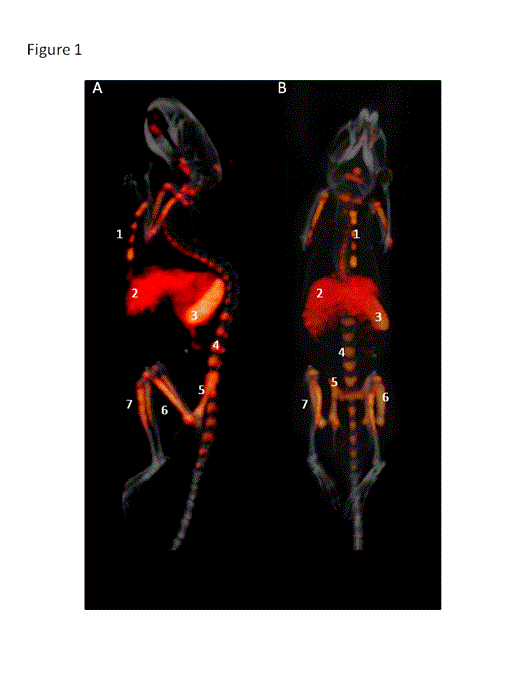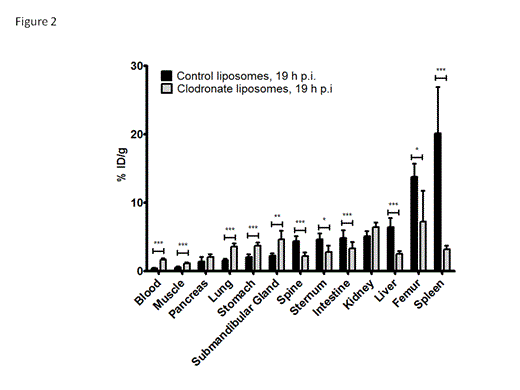Abstract
Asparaginase (ASNase) is one of the cornerstones of the multi-drug treatment protocol that is used to treat acute lymphoblastic leukemia (ALL) in pediatric and adult patients. Recent studies monitoring ASNase kinetics in patients provide evidence of a large inter-patient variability of serum ASNase concentrations and call attention to the negative effects of ASNase underexposure on treatment response and relapse risk. Despite the fact that ASNase has been used in ALL treatment protocols for decades, little is known about the biodistribution and the mechanism of ASNase turnover in patients.
We used in vivo imaging to study the distribution and pharmacodynamics of ASNase in a mouse model. We injected mice with 3,000 International Units (I.U.)/kg ASNase, which was labeled with 20-25 MBq Indium-111 (In-111) and acquired micro-SPECT/CT images up 18 hours post injection. At this timepoint, serum ASNase activity has dropped to levels close to the detection limits. In addition to the expected uptake in the liver, SPECT/CT imaging revealed a rapid, strong and specific accumulation of radiolabeled ASNase in the bone marrow and spleen (Figure 1). Accumulation in these organs was confirmed by quantitative measurement of radiolabeled ASNase in the dissected organs (Figure 2).
We hypothesized that macrophages which are present in high numbers in these organs, efficiently phagocytose the ASNase, thereby rapidly clearing the active enzyme from the blood. Autoradiography of spleen sections indeed showed high uptake of radiolabeled ASNase in the macrophage-rich red pulp of the spleen. Immunohistochemical stainings confirmed the presence of ASNase in cells positive for the murine macrophage marker F4/80.
To provide additional evidence for the potential role of macrophages in the turnover of ASNase, we pretreated mice with a single injection of clodronate liposomes, which almost completely depletes the relevant organs from phagocytic cells. This pretreatment diminished the accumulation of ASNase in the liver, spleen and the bone marrow (Figure 2). Consistent with this notion, we found that clodronate pretreatment more than doubles the circulatory half-life of serum ASNase activity.
We conclude from these experiments that ASNase is rapidly cleared from the serum by phagocytic cells. In particular, the efficient uptake of ASNase by spleen and bone marrow resident macrophages may protect leukemic cells from the nutrient depriving action of this drug and could thereby compromise therapeutic efficacy.
SPECT/CT image of Asparaginase uptake
Lateral (A) and ventral (B) 3-dimensional volume projections of fused SPECT/CT scans of mice injected with 111Indium-labeled asparaginase (pseudocolor images with red being least intense and yellow most intense), 18 hours post injection. Numbers indicate relevant organs: 1 sternum, 2 liver, 3 spleen, 4 spine, 5, pelvis, 6 femur, 7 tibia.
Biodistribution of Asparaginase in control and clodronate pretreated mice.
Biodistribution of Asparaginase in control and clodronate pretreated mice.
Asparaginase uptake is depicted as percentage of the injected dose per gram of tissue (%ID/g) at 19 hours after injection in control (empty liposomes) and clodronate pretreated mice. Results are mean + standard deviation (n=5 for each group). 2-tailed t-test was used to test for significance: * p<0.05, ** p<0.01, *** p<0.001
No relevant conflicts of interest to declare.
Author notes
Asterisk with author names denotes non-ASH members.



This feature is available to Subscribers Only
Sign In or Create an Account Close Modal